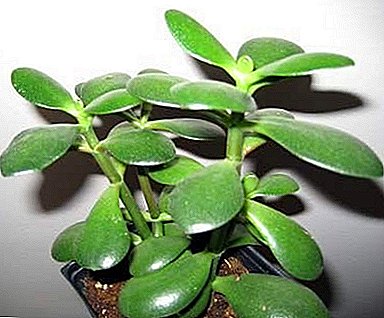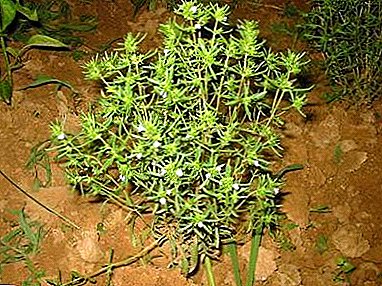 Animals, as well as people, can suffer from various disorders in the bowels. When the functionality of the normal intestinal microflora is disturbed, and harmful bacteria begin to dominate over opportunistic, problems arise: diarrhea, rash, weakened immunity, etc. To eliminate such symptoms, scientists have developed the drug "Vetom 1.1". In this article we will talk about the properties of this pharmacy, instructions for use for various birds (broilers, geese, pigeons, etc.), dogs, cats, rabbits, etc., as well as side effects and contraindications.
Animals, as well as people, can suffer from various disorders in the bowels. When the functionality of the normal intestinal microflora is disturbed, and harmful bacteria begin to dominate over opportunistic, problems arise: diarrhea, rash, weakened immunity, etc. To eliminate such symptoms, scientists have developed the drug "Vetom 1.1". In this article we will talk about the properties of this pharmacy, instructions for use for various birds (broilers, geese, pigeons, etc.), dogs, cats, rabbits, etc., as well as side effects and contraindications.
Composition and pharmacological properties
The composition of this white finely powdered substance includes a bacterial mass (Bacillus subtilis strain or hay bacillus). It is these bacteria that are the basis of this pharmacy substance.
Auxiliary nutrients are starch and ground sugar. The content of carcinogenic and harmful substances in the “Vetom 1.1” preparation does not exceed the norms specified in the legislation.
1 g of fine powder contains about a million active bacteria that are able to activate the synthesis of interferon.
Important! Vetom 1.1 according to GOST refers to the 4th class of hazard (low hazardous substances).
 The pharmacological properties of this pharmacy are based on the active action of the above strain. The bacterial mass of the drug "Vetom 1.1" is capable of activating the processes of alpha-2 interferon synthesis, which regulates almost all the processes in the organism of animals.
The pharmacological properties of this pharmacy are based on the active action of the above strain. The bacterial mass of the drug "Vetom 1.1" is capable of activating the processes of alpha-2 interferon synthesis, which regulates almost all the processes in the organism of animals.Due to the increase in the amount of interferon, the body's defenses increase, and animals are less exposed to various diseases. In addition, the bacterial strain improves the functioning of the intestinal microflora, contributes to the normal process of digestion.
Any inflammatory processes of the gastrointestinal tract will disappear after the therapeutic course of Vetom 1.1. Moreover, this pharmacy is actively used by poultry farmers and people who breed pigs, sheep, cattle, etc.
This drug contributes to the normalization of metabolism, as a result of which meat types of animals gain mass faster and are less susceptible to various diseases.
Due to the fact that the processes of metabolism of all vital micro- and macroelements are adjusted, the meat products of animals will be characterized by a high level of quality. 
For whom is suitable
Vetom 1.1 was originally developed as a drug for treating a human gastrointestinal tract disease. But due to the fact that the company-inventor did not have enough financial resources, the drug was made for use in veterinary medicine.
In order to treat and prevent intestinal diseases, Vetom 1.1 is used for such animal species:
- Pets, decorative, family pets (rabbits, guinea pigs, cats, parrots, dogs, raccoons, etc.).
- Agricultural and productive animals (pigs, chickens, geese, cows, horses, sheep, rabbits, nutria, pigeon meat breeds, etc.). Moreover, this tool is suitable for both adults and young animals (the difference is only in dosages).
- Wild animals (squirrels, foxes, etc.).
Learn more about such breeds of pigs as: karmal, petren, red-belt, Hungarian mangalitsa, Vietnamese vislobryukhaya, downy mangalitsa, dyurok, Mirgorod.
Although Vetom 1.1 is considered a veterinary medicine, many people use it to treat human intestinal disorders.
The tool is absolutely safe and can cause only minor adverse reactions in the presence of individual intolerance of the strain by the body. 
Release form
This tool is Packed in a plastic waterproof containers in the form of cans or flexible bags. Packings are different, depending on the mass (5 g, 10 g, 50 g, 100 g, 200 g, 300 g and 500 g).
Also, this drug is available in more reliable packages (with an internal polyethylene coating) of 1 kg, 2 kg and 5 kg. On each package indicate all the necessary data, according to GOST. In addition, instructions for use for animals are attached to any of the forms of release of Vetom 1.1. 
Indications for use
Vetom 1.1 is used for a variety of infectious and bacterial intestinal lesions. This pharmacy tool will become an indispensable helper for parvovirus enteritis, salmonellosis, coccidiosis, colitis, etc.
It is actively used by veterinarians to stimulate the immune system of animals in various infectious diseases (parainfluenza, plague, hepatitis, etc.).
Due to the strain of bacteria that cause an increase in the body's defenses, Vetom 1.1 is regularly used as a preventive measure against various lesions of the animals.
Did you know? The hay wand (the basis of Vetom 1.1) was first described by Ehrenberg in 1835.
 As a preventive measure and also to stimulate the growth of animals (used as dietary supplements), Vetom 1.1 uses:
As a preventive measure and also to stimulate the growth of animals (used as dietary supplements), Vetom 1.1 uses:- For the normalization of metabolic processes and metabolism in the intestine.
- To restore the normal functioning of the digestive tract after severe infectious and bacterial lesions.
- To stimulate the growth of young stock that is contained as beef cattle (also for the rapid growth of beef breeds of chickens, pigs, cows, geese, rabbits, etc.).
- For the general strengthening of the body of animals in order to prevent various diseases.
The drug is very effective and useful on large farms, agricultural land, where the number of heads of various livestock exceeds one thousand.
On large farms, Vetom 1.1 is regularly used for prophylactic purposes so that all pathogenic microorganisms do not start to consistently infect animals (herd affection).
Dosing and Administration
Use this pharmacy tool for the treatment and prevention of diseases in different dosages. The most optimal dosage as preventive measures is 1 time per day, 75 mg per 1 kg of animal weight.
Preventive courses usually take 5-10 days, depending on the type of animal and the purpose of prevention (from diseases, for weight gain, after past diseases, etc.).
Important! It is forbidden to use Vetom 1.1 for antibiotic treatment. In this case, the effect will not be from one or from another means.
 But, according to experienced veterinarians, the effect of the drug will be more effective if it is applied 2 times a day, 50 mg. The drug should be given to animals with water one hour before meals (in some cases, the powder can be mixed directly into food).
But, according to experienced veterinarians, the effect of the drug will be more effective if it is applied 2 times a day, 50 mg. The drug should be given to animals with water one hour before meals (in some cases, the powder can be mixed directly into food).If Vetom 1.1 is used as a treatment for intestinal diseases, then the therapeutic course should continue until full recovery.
Below are instructions for using Vetom 1.1 for some animal species for the purposes of prevention and treatment:
- For rabbits for the purpose of treatment this drug is used in a standard dosage (50 mg per 1 kg of body weight, 2 times a day). In extreme conditions of life (with epidemics, frequent stressful situations, etc.), Vetom 1.1 is used every three days with a dosage of 75 mg per 1 kg of weight. The entire course will take 9 days, that is, 3 doses of the drug.
You will also be interested to read about such breeds of rabbits as ram, rizen, flandr, white giant, butterfly, angora, gray giant, black-brown rabbit.
With severe disease in dogs This tool is used in a standard dosage 4 times a day until complete recovery. As prophylaxis or in case of lung diseases (weakening of the immune system, diarrhea, etc.), the drug is used for 5-10 days in a standard dosage (1-2 times per day).
- Dilute Vetom 1.1 for chickens need in food, as they may not drink water, and the effect of therapy will disappear. Standard dosages, course of prevention - 5-7 days.
- Pigs drug give to stimulate growth. The course of the drug lasts 7-9 days and repeats in 2-3 months. All dosages are standard (per 1 kg of weight 50 mg of powder).

Precautionary measures
In the indicated dosages, the agent does not cause a rash and local irritation. It is combined with any food and chemical preparations (except antibiotics). Be especially careful when used with chlorine-free water.
The strain of bacteria that make up Vetom 1.1 is sensitive to chlorine and its compounds, as well as to alcohol. Therefore, it is necessary to use boiled cooled water, which is purified from chlorine and its compounds.
Contraindications and side effects
Vetom 1.1 is not recommended for use in diabetes in animals, which is extremely rare. Also, this tool should be replaced by an analogue of those animals in which there is an individual sensitivity of the organism to the hay stick.
In any case, use this tool only after consulting a veterinarian, and you will have no problems.
In most cases, there are no side effects from Vetom 1.1. In rare cases, in case of acute infectious lesions of the intestine, a non-prolonged pain syndrome of moderate severity may occur.  There may also be diarrhea and increased gas separation, in addition, the animal may suffer from colic for some time. A multimillion bacteria in combination with chlorine can cause severe diarrhea and nausea.
There may also be diarrhea and increased gas separation, in addition, the animal may suffer from colic for some time. A multimillion bacteria in combination with chlorine can cause severe diarrhea and nausea.
Terms and conditions of storage
This tool should be maintained at a temperature of from 0 to 30 ° C in a dry place, with normal ventilation, in which the direct rays of the sun are not directed.
The preparation should be stored in a place where children cannot reach, in addition, Vetom 1.1 needs to be kept in hermetic original packaging. If you comply with all these standards, the tool will be suitable for use for 4 years.
Unsealed tool is suitable for use only for two weeks. At the end of this period, the drug must be disposed of, since it will no longer bring any effectiveness in the process of therapy.  In view of all that has been said in this article, we can conclude that Vetom 1.1 is an effective and safe pharmacy remedy for the treatment and prevention of gastrointestinal diseases in animals.
In view of all that has been said in this article, we can conclude that Vetom 1.1 is an effective and safe pharmacy remedy for the treatment and prevention of gastrointestinal diseases in animals.
The drug belongs to low-toxic substances, as a result, does not pose a danger to the organism of animals and humans. Reasonable price and high efficiency put this powder in the lists of leaders in its category.












